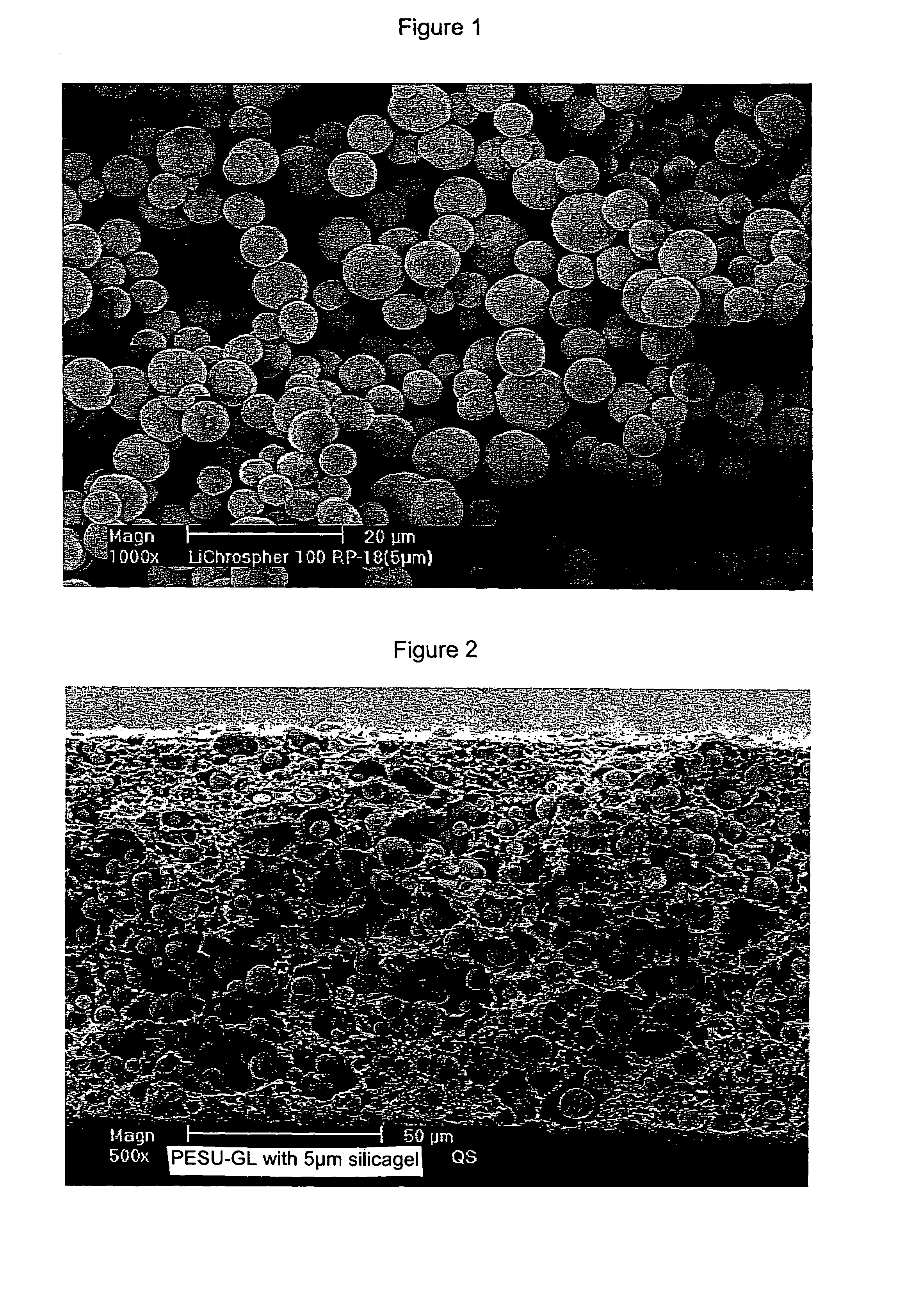Adsorption membranes, method of producing same and equipment, including the adsorption membranes
a technology of adsorption membrane and adsorption membrane, which is applied in the field of adsorption membrane, can solve the problems of unavoidable deleterious edge effects, complicated adsorption with the corresponding adsorbent, and negative analytical
- Summary
- Abstract
- Description
- Claims
- Application Information
AI Technical Summary
Benefits of technology
Problems solved by technology
Method used
Image
Examples
example 1
[0075]Production of Irregularly Shaped Agarose Particles
[0076]Commercially available agarose from SIGMA Deisenhofen (order number A-6013, lot number 22K 0081) in the amount of 4 g was suspended in 100 mL water and dissolved in a boiling water bath. The solution was cast on a steel plate to form a layer 5 mm thick. After cooling and solidifying, the plate was divided into four parts. In a glass dish, 200 mL of a solution of 15% BUDGE and 10% 1 N NaOH in water was added to the parts and agitated for five hours at 50 rpm at ambient temperature. The plates were soaked in running tap water for three hours, then stored in water at 4° C. To detect the stabilization of agarose due to crosslinking, approx. 5 g was boiled for ten minutes with 5 mL water in a test tube, during which the piece of agarose retained its shape, i.e., the agarose did not go into solution.
[0077]The plates were divided into pieces approx. 2 cm in size and were transferred to a glass bottle together with 200 mL water. ...
example 2
[0078]Producing a CDI-Activated Gel
[0079]Packed, sedimented gel from Example 1 in the amount of 10 mL was treated twice each with a 25%, 50% and 75% solution of acetone in water, then slurried twice with anhydrous acetone and centrifuged after five minutes. Carbonyldiimidazole (CDI, 1 g) from Fluka, Buchs, Switzerland (order no. 21860, lot number 36208 1187) was dissolved in approx. 15 mL acetone and added to the gel. This mixture was agitated at 400 rpm for one hour at room temperature, then centrifuged and washed again twice with acetone and centrifuged. The activated gel was stored in anhydrous acetone at 4° C.
example 3
[0080]Producing an Aldehyde-Activated Gel
[0081]Approximately 14 g moist sedimented gel from Example 1 was mixed with 14 mL water and 0.5 g sodium metaperiodate from Merck Darmstadt (order no. 106596, lot no. K23404696 726) and agitated at ambient temperature. After two hours, 50 mL water was added to the gel and centrifuged. The supernatant was decanted and 65 mL more water was added to the gel and the gel was slurried. After ten minutes it was centrifuged. To 1 mL Schiffs reagent from Merck Darmstadt (order no. 109034, lot no. 840296703) was added 0.1 mL of the packed gel and left to stand at ambient temperature. After 30 minutes, the gel had turned purple, indicating the presence of aldehyde groups.
PUM
| Property | Measurement | Unit |
|---|---|---|
| thickness | aaaaa | aaaaa |
| diameter | aaaaa | aaaaa |
| particle sizes | aaaaa | aaaaa |
Abstract
Description
Claims
Application Information
 Login to View More
Login to View More - R&D
- Intellectual Property
- Life Sciences
- Materials
- Tech Scout
- Unparalleled Data Quality
- Higher Quality Content
- 60% Fewer Hallucinations
Browse by: Latest US Patents, China's latest patents, Technical Efficacy Thesaurus, Application Domain, Technology Topic, Popular Technical Reports.
© 2025 PatSnap. All rights reserved.Legal|Privacy policy|Modern Slavery Act Transparency Statement|Sitemap|About US| Contact US: help@patsnap.com



